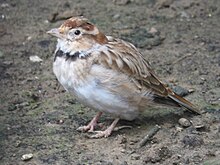The Mongolian lark (Melanocorypha mongolica) is a species of lark in the family Alaudidae found from southern Russia and Mongolia to central China.[2]
| Mongolian lark | |
|---|---|

| |
| Scientific classification | |
| Domain: | Eukaryota |
| Kingdom: | Animalia |
| Phylum: | Chordata |
| Class: | Aves |
| Order: | Passeriformes |
| Family: | Alaudidae |
| Genus: | Melanocorypha |
| Species: | M. mongolica
|
| Binomial name | |
| Melanocorypha mongolica (Pallas, 1776)
| |

| |
| Mongolian lark range, green - resident, yellow - breeding, blue - non-breeding | |
| Synonyms | |
| |
The Mongolian lark is known for its elaborate singing and even well into adulthood, is able to learn new songs. While female Mongolian larks don’t sing, they have noteworthy song control nuclei with strong connectivity. Male Mongolian larks have large song bouts and song phrases that allow them to have extremely large song control nuclei.[3]
It is an indicator species for avian biodiversity in the Mongolian steppes.[4]
It is most often seen alone.[4]
Its predators include the Saker Falcon.[5]
Taxonomy and systematics
editThe black lark was originally placed in the genus Alauda. Alternate names for the black lark include Mongolian sand-lark and Mongolian skylark.[6]
Description
editIts head is pale brown, with a red crown.[7] Its upper part is reddish-brown, and its lower part is yellowish-white.[7]
Nesting
editOn average, it lays clutches of 3.3 eggs and incubates them for 13 days.[8] They remain nestlings for 10 days.[8] About half of its eggs tend to survive.[8]
References
edit- ^ BirdLife International (2016). "Melanocorypha mongolica". IUCN Red List of Threatened Species. 2016: e.T22717295A94526964. doi:10.2305/IUCN.UK.2016-3.RLTS.T22717295A94526964.en. Retrieved 11 November 2021.
- ^ "Nicators, reedling & larks - IOC World Bird List". www.worldbirdnames.org. Retrieved 2016-12-15.
- ^ Zhang, X.; Zeng, S.; Zhang, X.; Zuo, M. (2011). "Comparative study on the song behavior and song control nuclei in male and female Mongolian larks (Melanocorypha mongolica)". Behavioural Brain Research. 222 (1): 98–105. doi:10.1016/j.bbr.2011.03.044. PMID 21440576. S2CID 41964632.
- ^ a b Han, Zheng; Yang, Xi; Zhao, Xueqi; Jiguet, Frédéric; Tryjanowski, Piotr; Wang, Haitao (2023). "Mongolian Lark as an indicator of taxonomic, functional and phylogenetic diversity of steppe birds". Avian Research. 14: 100124. doi:10.1016/j.avrs.2023.100124. ISSN 2053-7166.
- ^ Mainjargal, Galbadrakh; Boldbaatar, Shagdarsuren; Enkhbileg, Dulamtseren; Gantugs, Sovd; Otgonbayar, Baatargal; Tuvshintugs, Sukhbaatar; Bayanmunkh, Dashnyam; Munkh-Erdene, Jamsran; Odkhuu, Biraazana; Gombobaatar, Sundev (2021-12-06). "Population and conservation issues of Saker Falcon (Falco cherrug Gray, 1834) in Mongolia". Proceedings of the Institute of Biology. 38 (1): 64–87. doi:10.5564/pib.v38i1.2537. ISSN 2788-9823.
- ^ "Melanocorypha mongolica - Avibase". avibase.bsc-eoc.org. Retrieved 2016-12-15.
- ^ a b KIM, Jin; KANG, Tae Hwa; JUNG, Bu Hee (September 2004). "A Newly Recorded Species of the Family Pythidae (Coleoptera) from Korea". Entomological Research. 34 (3): 159–161. doi:10.1111/j.1748-5967.2004.tb00107.x. ISSN 1738-2297.
- ^ a b c Liu, Jinlong; Yan, Han; Li, Guopan; Li, Shaobin (2021-09-17). "Nest concealment is associated with reproductive traits across sympatric bird species". Ecology and Evolution. 11 (20): 14079–14087. doi:10.1002/ece3.8117. ISSN 2045-7758. PMC 8525109.
